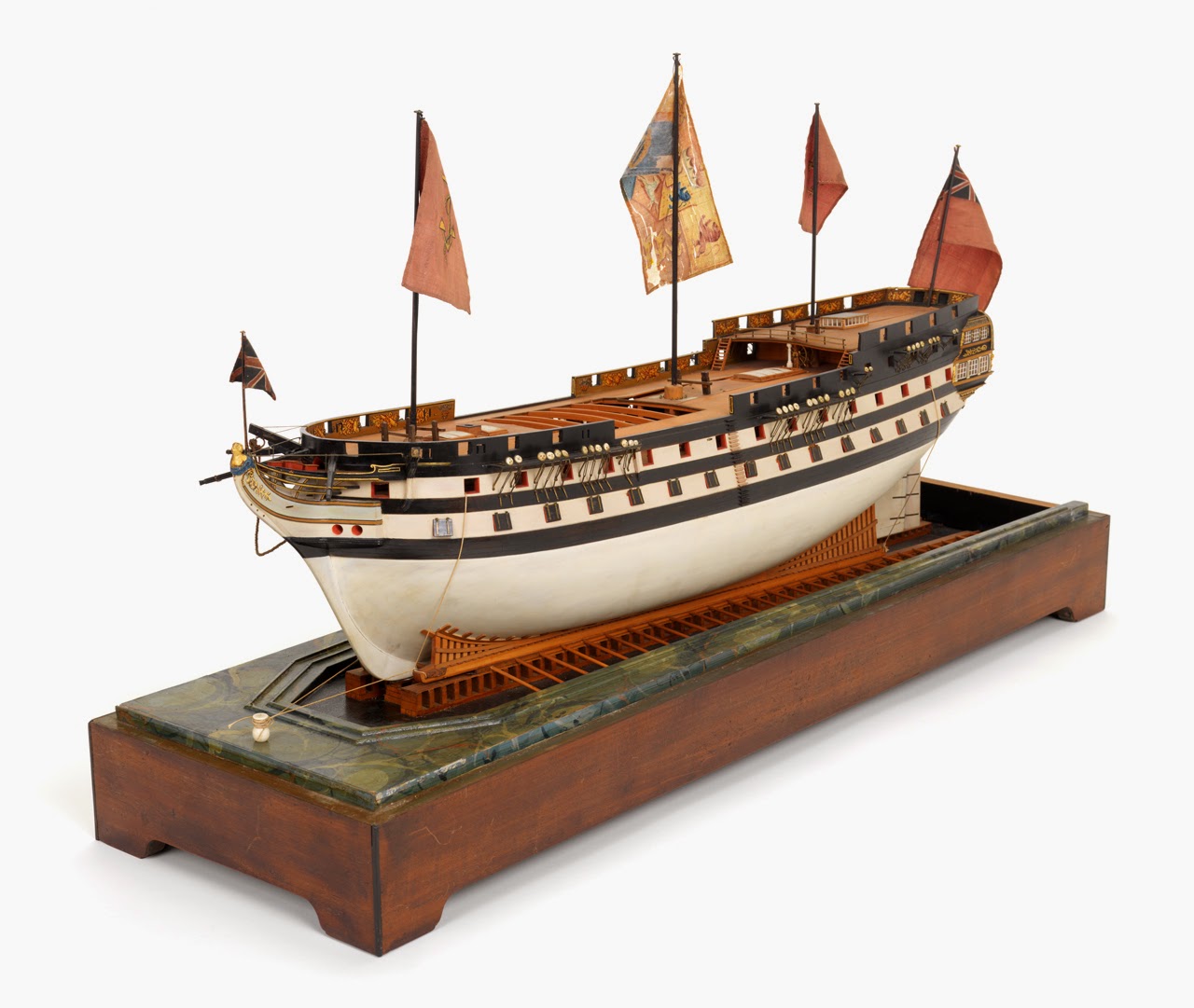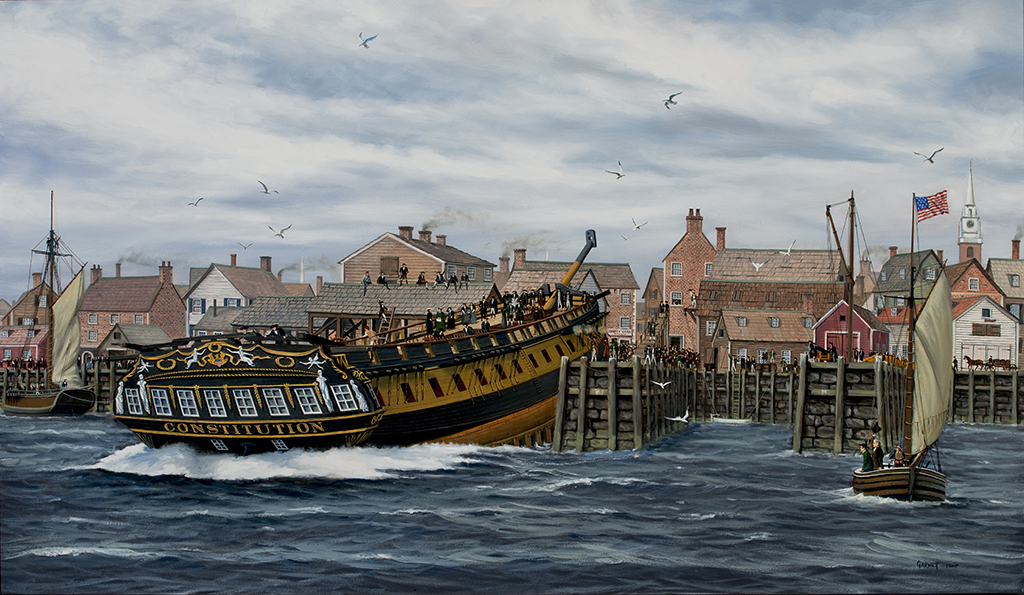George Claghorn had a problem. For three years the naval constructor, charged with overseeing the building of one of the United States’ new frigates, had overcome every obstacle. First, the copper bolts ordered from England had been too large. There had been timber shortages, and interminable delays delivering live oak from the coast of Georgia. And then Congress threatened to suspend the building program altogether. Nevertheless, in the words of the one newspaper editor, the ship he completed was “a perfect model of elegance, strength and durability.”
But now, on September 20, 1797, Claghorn had to move this huge and heavy ship from dry land into Boston Harbor. In the words of David Steel (in his monumental Elements and Practice of Naval Architecture of 1805), “the launch of a ship, or machinery by which she is safely conveyed into the water, after she is completely built, is a grand piece of mechanism, and requires every consideration.” In fact, plans for launching a ship had to be well thought out before shipwrights even cut the first timber.
When the government chose Edmund Hartt’s shipyard for building the ship, workers had to first prepare the ground. No one had built a ship this large in Boston, and the slipway where Claghorn and his crew would lay the keel had to be lengthened. Joseph Green delivered 76 tons of stone to elongate the wharf, and Samuel Green and James Fenno brought 145 tons of stone to make secure footings for the launching ways. Over this firm footing, shipyard works began to construct the “groundways.”
They laid the first layer, probably composed of oak beams, flush with the surface of the slip and secured them with stakes. After filling the gaps with packed earth, the workers began to stack squared pine timbers alternately lengthwise and crosswise. Claghorn believed that the optimal angle for the launching ways would be provided by a declivity of 5/8 of an inch to the foot. Because the keel was about 145 feet long, the ways had to be stacked more than 7 ½ feet tall at the bow. Once the pine timbers had been carefully leveled, workers fastened two rows of oak “sliding planks” on both sides. These formed the ramp down which the ship would slide. To keep the ship from slipping off during launch, parallel ribbands, or stops, were fastened to the outside edge of the sliding planks.
Next, workers placed “splitting blocks” the length of the ways, making sure to observe the same declivity. The keel would be laid on these blocks. Made of clear-grained pine, the blocks could be split and removed from under the keel when it was time to launch the vessel.
As the ship took form, shipwrights erected a series of shores and braces to prevent it from toppling over. By June 1797 the bottom of the ship had been fully planked and squared off. In July, workers began nailing the copper sheathing to the bottom, and by August the ship was nearly ready for launching. Shipwrights now constructed a launching cradle that would move the ship into the water.
The cradle functioned like a giant sled. Two long skids or “bilgeways” were laid on top of the sliding planks, parallel with the keel. From the bilgeways rose a series of planks and uprights called “poppets” that formed a structure not unlike a modern boat trailer. Once the keel blocks were split away, the full, immense weight of the ship rested on the cradle.

On September 20, the yard workers performed all these steps to perfection, but nothing happened. Using a set of screw jacks provided by one Samuel Adams (not the brewer/Son of Liberty/governor, but a lighterman living on Elliot Street), the ship began to move, but came to a stop after traveling only 27 feet. With the tide ebbing fast, a perplexed Claghorn ordered shores and blocks replaced and began to investigate what had happened. “I found that the part of the ways which had not before received any of the weight, had settled about half an inch, which added to some other cause of no great importance in itself, had occasioned the obstruction.” The other cause “of no great importance” proved to be a four by six inch stone on one of the sliding planks. “The weight of the ship had pressed it completely into the timber.”As the tide began to rise, workers smeared a thick coating of oil and tallow on the sliding planks (they had already applied the same to the underside of the bilgeways). At the appointed time, a few brave and nimble-footed souls knocked out the remaining shores and blocks, the ropes securing the cradle to the head of the slip were cut with an axe, and the ship was free to slide into the water.
There was nothing to do but try again. The next day, the shipwrights performed the herculean task of raising the entire ship two inches with wedges (a task they accomplished in only 50 minutes). They removed the bilgeways, straightened the sliding planks, and on September 22 made another attempt to get the ship into the water. This time, it move 31 feet and then ground to a halt. The ship had now shifted its weight onto the new wharf built to lengthen the building slip. Claghorn inspected the ways and found “they have both settled abaft, about 1 5/8th of an inch; which circumstance, as it could not have been foreseen, the descent of the ways was not calculated to overcome, and which solely occasioned the ship to stop.
Poor Claghorn! Here, in front of dignitaries and a large portion of the population of Boston and the surrounding towns, he had twice failed to launch the ship. In a letter to Elias Boudinot, Rachel Bradford observed that Claghorn “actually appeared to have lost flesh in eight and forty hours, from mortification and vexation.” What was worse, the opponents of the shipbuilding program and the federal government now had an abundance of inspiration for their “impudent speeches….sad predictions and sarcastic remarks.”
One such production came from the pen of Democratic-Republican poet Philip Freneau. The last two stanzas of his caustic poem read:
Each anti-federal, with a smileObserved the yet unfloating pileAs if he
meant to say,Builder, no doubt, you know your trade,A constitution you have madeBut should her ways have better laid.Well now to heave the ship afloat,To move from this unlucky spot,Take our
advice, and give them soon,What should have long ago been done,Amendments – You Know What.
Despite the criticisms and Claghorn’s considerable chagrin, the ship did at last enter Boston Harbor. Shipyard workers increased the angle of the ways to overcome the “defect occasioned by the settling of the new wharf,” and at high tide on October 21, 1797, Constitution at last floated in its “destined element.”

The Author(s)
Matthew Brenckle
Research Historian, USS Constitution Museum
Matthew Brenckle was the Research Historian at the USS Constitution Museum from 2006 to 2016.